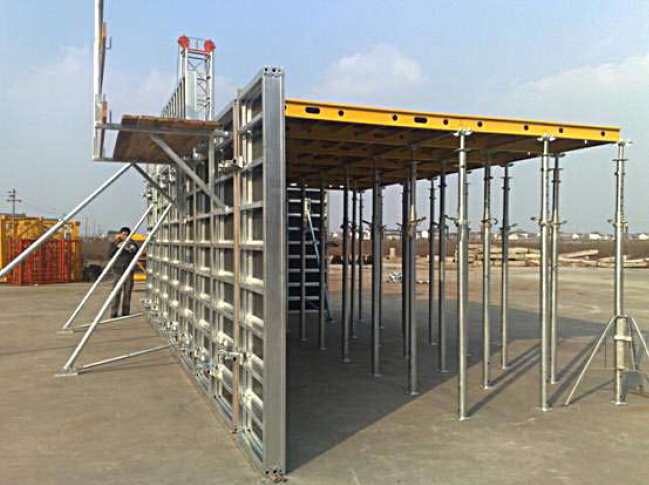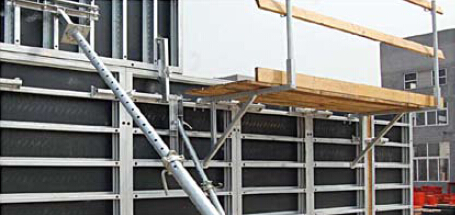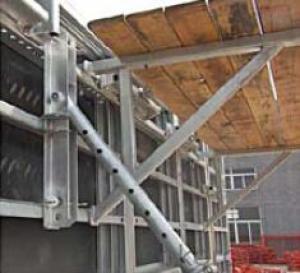Steel-Frame working platformfor Formwork and Scaffolding systems
- Loading Port:
- Tianjin
- Payment Terms:
- TT OR LC
- Min Order Qty:
- 50 m²
- Supply Capability:
- 1000 m²/month
OKorder Service Pledge
OKorder Financial Service
You Might Also Like
Steel-frame Formwork SF-140
Characteristics:
◆ Few parts for fast forming.
◆ Max. Concrete pressure: 80KN/m2.
◆ Hot-dip galvanized steel frame.
◆ The thickness of plywood is 18mm & the panel is 14cm.
◆ Compatibility with Hunnebeck Manto system due to similar edge profile.
System Details & Application:
◆ Neat joint and fast assembling with aligning panel clamp.
◆ Flexible panel arrangement and height extension.
◆ The selection of panels.
◆ Kinds of panel connectors.
◆ Corner clamp application.
◆ Length adjustment application.
◆ Height adjustment & aligning strut.
◆ Walkway bracket & platform.


- Q:How much time does it take to install steel formwork?
- The time it takes to install steel formwork can vary depending on various factors such as the size and complexity of the project, the expertise of the workers, and the availability of equipment. However, on average, it typically takes several hours to a few days to complete the installation process.
- Q:How does steel formwork handle concrete bleeding?
- Steel formwork is an excellent choice for handling concrete bleeding. Concrete bleeding refers to the process where water in the concrete mixture rises to the surface, resulting in the separation of the water from the solid components. Steel formwork is designed to have a smooth and non-porous surface, which helps to prevent excessive bleeding and the loss of water from the concrete mixture. The tight joints and connections of steel formwork also minimize the chances of water seepage, ensuring that the concrete retains its desired water content. Additionally, steel formwork provides excellent support and stability to the concrete during the pouring and setting process. This prevents the formation of voids or gaps within the concrete, reducing the risk of excessive bleeding. The rigidity of steel formwork also helps to maintain the shape and structure of the concrete, preventing any deformation or cracking that may occur due to bleeding. Moreover, steel formwork allows for easy and efficient removal of excess water from the concrete surface. The smooth and non-absorbent nature of steel formwork facilitates the use of various techniques, such as squeegeeing or vacuuming, to remove the excess water, reducing the bleeding effect. In summary, steel formwork handles concrete bleeding effectively by providing a smooth and non-porous surface, minimizing water seepage, ensuring stability and support to the concrete, and allowing for efficient removal of excess water.
- Q:Can steel formwork be used for structures with high chemical resistance requirements?
- No, steel formwork is not suitable for structures with high chemical resistance requirements. Steel is prone to corrosion and is not resistant to many harsh chemicals. When exposed to chemicals, steel formwork can deteriorate and lose its structural integrity, compromising the stability and safety of the structure. In such cases, alternative materials like chemically resistant plastics or composites should be considered to ensure the longevity and durability of the structure in environments with high chemical exposure.
- Q:How does steel formwork affect the overall noise transmission in the building?
- Steel formwork can have a positive impact on reducing noise transmission in a building. Its solid and dense structure acts as a barrier, effectively blocking the transmission of sound waves. Additionally, steel formwork is known for its excellent vibration-damping properties, further minimizing noise transmission. Therefore, by using steel formwork, the overall noise levels within the building can be significantly reduced, resulting in a more peaceful and comfortable environment for occupants.
- Q:What are the common design considerations for steel formwork systems?
- There are several common design considerations for steel formwork systems that should be taken into account to ensure the successful construction of a project. Firstly, the load-bearing capacity of the steel formwork system is a crucial consideration. The formwork must be able to safely support the weight of the concrete being poured and any additional loads such as workers or equipment. This requires careful calculation and analysis to determine the appropriate thickness and reinforcement of the steel formwork. Secondly, the formwork system should be designed to provide adequate stability and resistance against lateral forces. This is particularly important in high-rise or complex structures where wind or seismic loads may be significant. The design should incorporate bracing and anchorage systems to ensure the formwork remains stable during construction. Another important consideration is the ease of assembly and disassembly of the steel formwork system. The design should allow for efficient installation and removal, minimizing labor and time requirements. This often involves the use of modular components and standardized connections that can be easily assembled and dismantled. Additionally, the formwork system should be designed to accommodate any necessary adjustments or modifications. Construction projects often require changes or adaptations during the construction process, and the formwork should be flexible enough to accommodate these changes without compromising structural integrity. Furthermore, safety considerations play a vital role in the design of steel formwork systems. The formwork should be designed to provide a safe working environment for construction workers, with features such as handrails, access platforms, and non-slip surfaces. Additionally, the design should consider potential hazards, such as sharp edges or protruding elements, and incorporate appropriate safety measures to mitigate these risks. Lastly, the durability and longevity of the steel formwork system should be taken into account. It should be designed to withstand the harsh conditions of construction, including exposure to weather, chemicals, and repeated use. This may involve the use of corrosion-resistant materials or protective coatings to ensure the longevity and performance of the formwork system. In conclusion, the common design considerations for steel formwork systems include load-bearing capacity, stability against lateral forces, ease of assembly and disassembly, adaptability to changes, safety features, and durability. By carefully considering these factors, engineers can design a steel formwork system that meets the specific requirements of a construction project and ensures its successful execution.
- Q:Is steel formwork reusable?
- Yes, steel formwork is reusable. It is a durable and sturdy material that can be dismantled and used multiple times for different construction projects.
- Q:Can steel formwork be used for marine construction projects?
- Yes, steel formwork can be used for marine construction projects. Steel is a durable material that can withstand harsh marine conditions, including exposure to saltwater, waves, and corrosive elements. Steel formwork provides the required strength and stability to withstand the forces exerted by the marine environment. It can be used for various marine construction applications, such as building seawalls, piers, jetties, and offshore structures. Additionally, steel formwork offers advantages such as easy assembly and disassembly, reusability, and the ability to create complex shapes and structures. However, proper corrosion protection measures, such as galvanization or the use of anti-corrosive coatings, should be implemented to ensure the longevity and performance of the steel formwork in marine environments.
- Q:How does steel formwork help in achieving a high-quality finish?
- Steel formwork helps in achieving a high-quality finish due to its ability to provide a strong and rigid structure for concrete placement. Its smooth and non-absorbent surface prevents the formation of air bubbles, resulting in a smooth and even finish. Additionally, steel formwork allows for precise and accurate shaping and alignment, ensuring the desired dimensions and contours of the final concrete product.
- Q:How does steel formwork perform in fire-resistant structures?
- Fire-resistant structures benefit greatly from the exceptional performance of steel formwork. Steel possesses inherent properties, including a high melting point and strength, which make it an ideal material for withstanding high temperatures and maintaining structural integrity in the event of a fire. To begin with, steel formwork exhibits non-combustible characteristics, meaning it does not contribute to the spread or intensity of a fire. Unlike certain construction materials, it does not burn or release harmful gases when exposed to flames. This quality aids in preventing the rapid propagation of fire within the structure, affording valuable time for evacuation and fire suppression efforts. Furthermore, steel possesses a high melting point in comparison to other commonly used formwork materials such as wood or plastic. This attribute enables steel formwork to retain its structural integrity even when subjected to intense heat. It can endure temperatures well above 1000°C (1832°F) without significant deformation or collapse, ensuring the stability of the structure and minimizing the risk of sudden structural failure during a fire. Moreover, steel formwork exhibits excellent load-bearing capabilities, even under high temperatures. This characteristic is crucial in fire-resistant structures as it allows the building to maintain its structural capacity when exposed to fire. The ability of steel formwork to bear the weight of the structure, even when compromised by fire, helps prevent structural collapse and ensures the safety of occupants and emergency personnel. Additionally, steel formwork is known for its durability and longevity, which are essential qualities in fire-resistant structures. It can withstand the effects of fire, such as thermal expansion and contraction, without sustaining significant damage. This durability ensures that the formwork can be reused or remain in place for future fire events, providing ongoing fire protection for the structure. In conclusion, steel formwork demonstrates exceptional performance in fire-resistant structures. Its non-combustible nature, high melting point, load-bearing capabilities, and durability make it a reliable choice for maintaining the structural integrity and safety of the building in the event of a fire.
- Q:What are the considerations when selecting the size and spacing of steel formwork panels?
- When selecting the size and spacing of steel formwork panels, several considerations need to be taken into account. First, the size of the panels should be determined based on the dimensions of the concrete structure being formed. The panels should be able to accommodate the desired shape and size of the concrete element. Secondly, the spacing between the panels should be chosen to ensure adequate support and stability. The spacing should be determined based on the load-bearing capacity of the panels and the weight of the concrete being poured. It is important to have proper spacing to prevent deflection or deformation of the formwork. Additionally, the size and spacing of the panels should also consider the ease of handling and installation. Panels that are too large or heavy may be difficult to transport and assemble, leading to time and labor inefficiencies. On the other hand, panels that are too small may result in excessive joints, increasing the chances of leakage or misalignment. Overall, the selection of the size and spacing of steel formwork panels should prioritize structural integrity, functionality, and ease of use to ensure successful and efficient concrete formwork construction.
1. Manufacturer Overview |
|
|---|---|
| Location | |
| Year Established | |
| Annual Output Value | |
| Main Markets | |
| Company Certifications | |
2. Manufacturer Certificates |
|
|---|---|
| a) Certification Name | |
| Range | |
| Reference | |
| Validity Period | |
3. Manufacturer Capability |
|
|---|---|
| a)Trade Capacity | |
| Nearest Port | |
| Export Percentage | |
| No.of Employees in Trade Department | |
| Language Spoken: | |
| b)Factory Information | |
| Factory Size: | |
| No. of Production Lines | |
| Contract Manufacturing | |
| Product Price Range | |
Send your message to us
Steel-Frame working platformfor Formwork and Scaffolding systems
- Loading Port:
- Tianjin
- Payment Terms:
- TT OR LC
- Min Order Qty:
- 50 m²
- Supply Capability:
- 1000 m²/month
OKorder Service Pledge
OKorder Financial Service
Similar products
New products
Hot products
Related keywords























